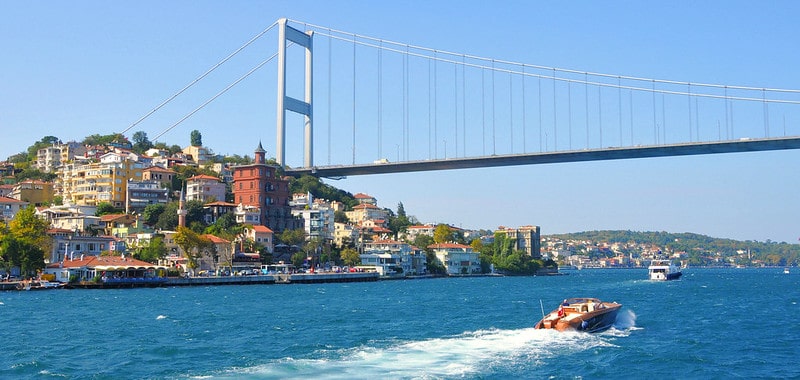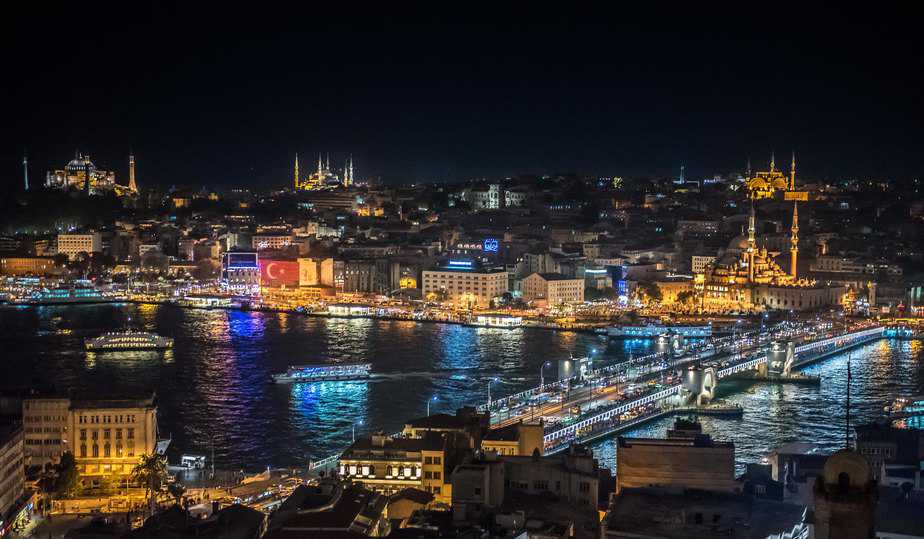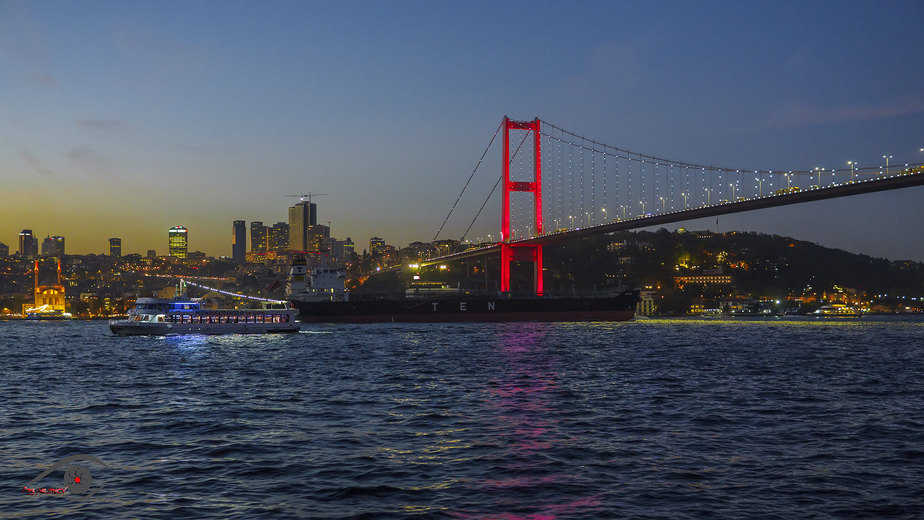Top 5 Most Beautiful Bridges in Istanbul
Tourists never tire of seeing images of bridges over the Bosphorus (Boğaz in Turkish) Straits and the Golden Horn (called Haliç in Turkish) estuary in the metropolitan city of Istanbul. It’s a popular image portrayed in photographs, especially of the romanticized image of the Galata bridge or the breathtaking images of the modern bridges.
With the expansion of Istanbul becoming a megacity with more than 15 million people, the Straits have a few bridges, with the most recent one being the third Bosphorus bridge called the Yavuz Sultan Selim Bridge.
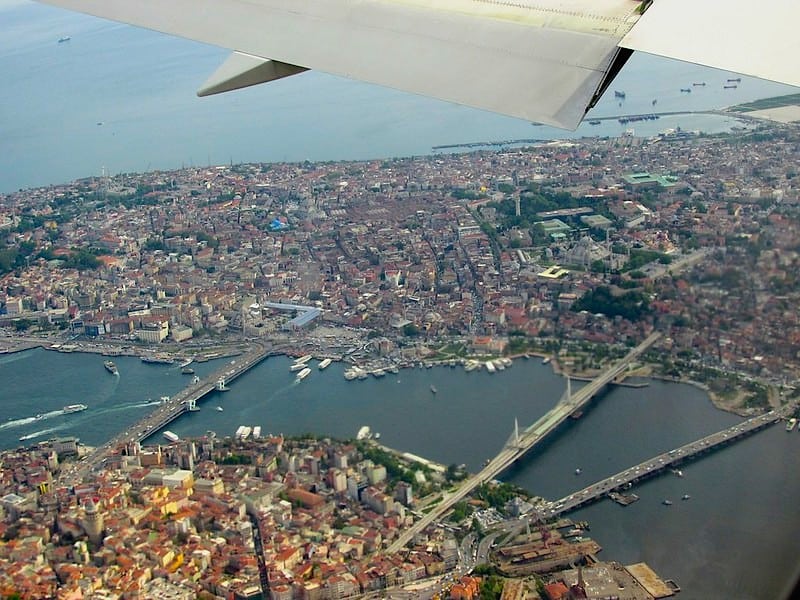
Golden Horn/Haliç with its bridges from the air, image sourced from Flickr
Istanbul is often represented in film and literature as “a bridge” between the East and the West. The use of bridges as a visual element has been used to represent Istanbul and Turkey itself throughout history — between progress and tradition, desired and imagined notions of belonging and otherness, usually in relation to Europe. In other words, bridges have become literal representations of the country and the city itself.
According to historical records, several emperors and engineers have proposed the building of bridges in Istanbul. Leonardo da Vinci, as well as Michelangelo’s names, are noteworthy, for instance. Furthermore, a tunnel under the Bosphorus was proposed in 1891. It was finally realized when the underwater rail tunnel, the Marmaray and the motorway-only Eurasia Tunnel were constructed and opened in 2015 and 2016.
A City of Bridges
The first bridges across the city that is now Istanbul go back to Justinian the Great in the 6th century. The bridge was built near the Theodosian Walls all the way to the other side. As for the Bosphorus straits, around 513-516 B.C.E, the ambitious Persian King Darius ordered a bridge of boats. It would be made to cross the waterways to pursue the Scythians in Thrace. It is believed that this bridge was around the same area where the actual second Bosphorus bridge stands today.
In 1453, during the campaign for the fall/conquest (depending on who you ask) of Constantinople, it is said that boats were linked together to make a bridge for Mehmed’s troops to cross the Bosphorus.
In the 1502 or 1503, Leonardo da Vinci proposed two bridges to Mehmed’s son, Sultan Bayezid via a letter — one was for the Golden Horn and the other for the Bosphorus. The proposal of the bridge and its sketch can be found in France today and the letter that he wrote is in Topkapı Palace’s archives. The bridge would be 240 m (790 ft.) long and 24 m (79 ft.) wide. Today, this idea and Leonardo’s design lives on via the Vebjørn Sand da Vinci Project in Oslo, Norway.
Several other people have proposed numerous bridges during the Ottomans’ long reign, but few made it past the ideation, proposal and approval stages. During the reign of Abdulmecit I, a design was first exhibited in 1855 at the Exposition Universelle in Paris for a bridge across the Bosphorus. It was to connect the railways between Europe and Asia.
The archway bridge was to be built from the city centre (at the time, this was the Seraglio Point or Sarayburnu) where the Palace was, to Üsküdar. Another proposal in 1867 at the same world fair was exhibited by Austrian Karl von Rupert. His bridge would have two piers in the sea and be adorned with sculptures.
There are several bridges in Istanbul today, so let’s take a look at the top 5!
1. Galata Bridge
While not the most glamorous of bridges, Istanbul’s Galata Bridge holds a special place in the hearts of its current inhabitants, its writers and poets. It’s the first bridge constructed in the city’s waterways connecting Eminönu, near the Spice Bazaar and the Yeni Camii or New Mosque to the Karaköy area.
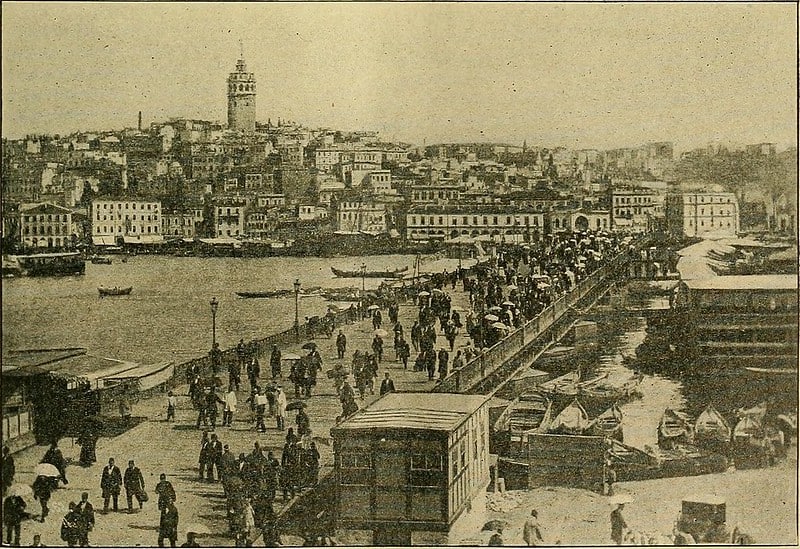
Galata Bridge in 1873, image sourced from Flickr
The bridge that connects the two sides of the Golden Horn today is the fifth bridge that’s currently in use. The earlier ones were made of wood and were eventually replaced. A number of European firms and engineers were employed such as British firm G. Wells and German firm Hüttenwerk Oberhausen AG, for instance.
The very first pontoon bridge was built in 1845 by the mother of Sultan Abdülmecid I and he was the first one to cross this bridge after its completion. Later, it was replaced by another in 1863. Subsequent bridges were built in 1875 and in 1912. The last one lasted until the 1990s. When a fire badly damaged the fourth bridge, it was replaced in 1992. This fifth bridge was built by a Turkish company and it is a bascule steel bridge, unlike the previous ones.
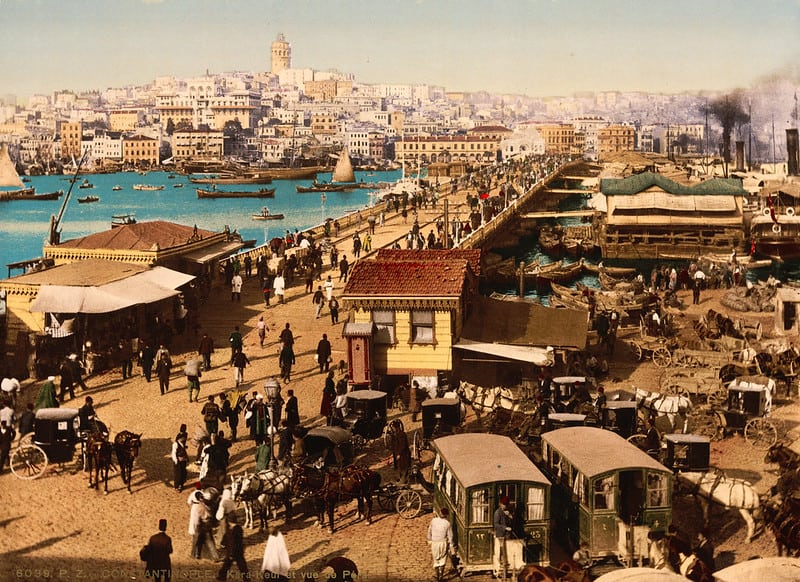
Galata Bridge between 1890-1900, image sourced from Flickr
The bridge’s site is a place of importance given the many changes Istanbul experienced during its long history. It connects European Istanbul (Pera/Beyoğlu) to the more traditional old Fatih district. This is where all the ancient sites such as Hagia Sophia, the Blue Mosque and the Topkapı Palace complex. By crossing this bridge, the traveller would be travelling between two worlds, two civilizations.
Popular but quite familiar images of the Galata bridge lives on in the many films, books, online blogs and travel books. Today, the bridge is one of the busiest bridges with its heavy traffic. The pedestrian area of the bridge is usually lined with dozens of fish anglers. The bottom part is where you’ll find fish restaurants.
With the urbanization and population increase in Istanbul, the city’s modern tramway system was built to pass through the bridge. On either side of the bridge, you’ll see many street vendors with their goods. Try Istanbul’s famous balık ekmek which the area is known for.
2. 15 July Martyrs Bridge
The Bosphorus Bridge served as the country’s efforts for modernization when it was inaugurated in 1973. Officially known as the 15 July Martyrs Bridge today, it extends from the Ortaköy neighbourhood to Beylerbeyi district in Asia. It is officially known as the martyrs’ bridge in commemoration of the failed coup in 2016. The bridge was blocked on the night of the coup and many lives were lost there.
The beautiful Mecidiye Mosque is frequently featured alongside the bridge and this spot is a popular place for photography. As you cross the bridge to the Asian side, you can see the mosque on your immediate right as well as the sprawl of Istanbul.
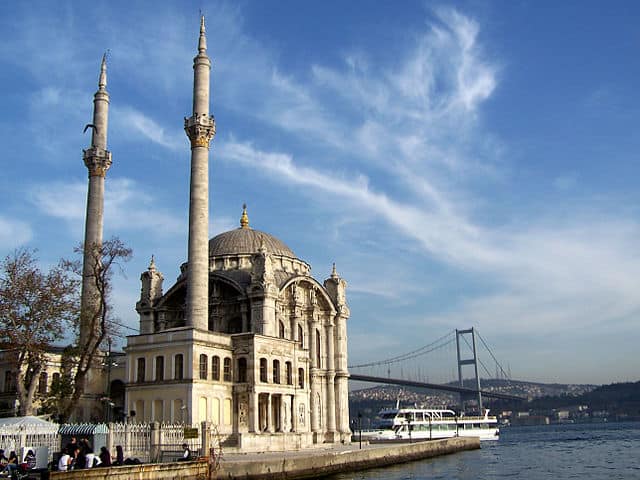
Image sourced from Wikimedia Commons
A gravity-anchored steel suspension bridge, it was completed in 1973. It is 1,560 m long, 33 m wide, the main span of 1,074 m and is suspended above the waters at 64 m. It has 8 lanes, with 6 for vehicles, one for emergencies and one pedestrian. The pedestrian lanes are no longer used as the service is no longer allowed. Nonetheless, pedestrians could use elevators to use the lanes for the first three years of the bridge’s operations.
The bridge is also used for the International Istanbul Eurasia Marathon every year. A few international sports stars have also used the bridge for advertising purposes. These include tennis champion Serena Williams, Formula 1 racer David Coulthard and golf player, Tiger Woods.
3. Fatih Sultan Mehmed Bridge
The second bridge to be built across the Bosphorus, it was completed in 1988. It extends further up the Straits from Hisarüstü to Kavacık in the Beykoz neighbourhood.
The bridge is named after Fatih Sultan Mehmed, the Ottoman sultan who captured and conquered Constantinople. The Rumeli fortress built by Mehmed in 1452 stands the test of time nearby. The fortress was built at the narrowest part of the waterway and opposite the Anadolu Hisar.
It is visually similar in looks to the first bridge and was constructed to ease traffic. Similarly, it is also gravity-anchored and has vertical hangers and steel pylons. The length of the bridge is 1,510 m with a width of 39 m and the main span of 1,090 m. The bridge suspends itself above the waters at 64 m.
A number of companies both local and international took part in the design and construction of the bridge. When it was completed, the bridge was the 5th longest suspension bridge in the world.
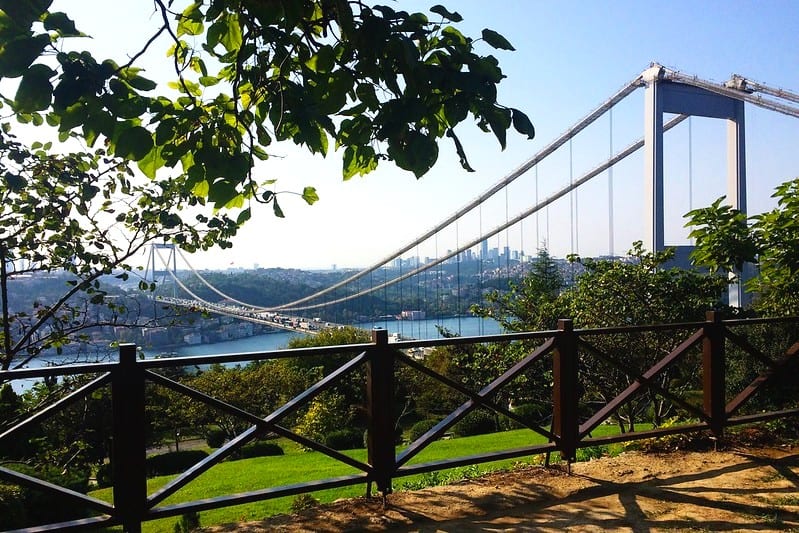
The bridge from Otağtepe, image sourced from Flickr
Furthermore, the surrounding areas of the bridge have their own historical and cultural stories. The uncompleted Perili Kösk or the Haunted Mansion (the red building on the left in the above photo) is one example. Today, this unusual building houses the Borusan Contemporary Art Gallery that can be visited on the weekends. On the other side of the bridge in Asia, it passes beside the lesser-known Otağtepe Fatih Grove. An amazing view of the bridge and the panorama of Istanbul awaits you here.
4. Haliç Metro Bridge
The Golden Horn’s only metro bridge, this one is used for both Istanbul’s metro transportation and as a pedestrian crossing. The intention to built such a bridge goes back to the 1950s but it was only realized in the mid-2000s.
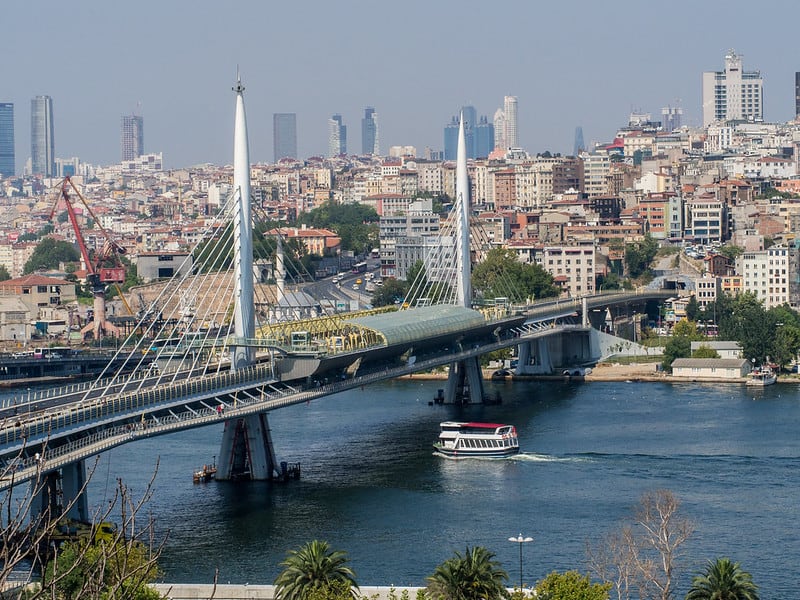
Image sourced from Flickr
Designed by Michel Virlogeux who also designed the third bridge (below), the project was completed keeping in mind Istanbul’s skyline and not to disrupt the old district’s UNESCO world heritage status. The project underwent numerous delays and revisions due to the discovery of Byzantium-era vault, basilica and graveyard were found.
The cable-stayed bridge is 936 m long and is 460 m above the water and was constructed in 2014. A part of the bridge also has a swing bridge to allow large ships to pass through. The bridge is used on the M2 metro line with Şişhane, Haliç and Vezneciler stations near the Sahaflar second-hand books market and Grand Bazaar.

Image sourced from Pixabay
More importantly, it connects the European side all the way from Sarıyer to Istanbul’s transportation hub Yenikapı. A metro station is situated on the bridge itself and gives you a great view of both sides of the bridge. It provides a unique experience of seeing Istanbul’s sights. If you’re staying in a hotel the European part of Istanbul for your vacation, then getting to/from the old district is easy when you use this metro line.
5. Yavuz Sultan Selim Bridge
The newest and third bridge to span the Bosphorus is the Yavuz Sultan Selim Bridge and it started operating in August 2016.

Image sourced from Flickr
The structural engineer and bridge specialist Michel Virlogeux served as the bridge’s architect while T-Engineering, a Swiss company, oversaw the project. It is built with both public and private partnerships. A Turkish and an Italian firm together created the ICA Construction consortium which managed and built the bridge. Recently, a Chinese company has also taken a stake in the operating of the bridge given the recent economic crisis that hit Turkey.
The cable-stayed hybrid bridge is 2,164 meters long. It’s the widest suspension bridge (at 59 meters) in the world. It’s also the highest bridge at 322 meters. The main bridge span is 1,408 meters above the surface of the Bosphorus waters.
The bridge is designed for both vehicles, rail and pedestrian usage. Considered the largest bridge in Turkey, it has 8 car lanes, 2 high-speed railway lines and 2 pedestrian walkways. Furthermore, like all the other bridges, it is a toll-operated bridge.
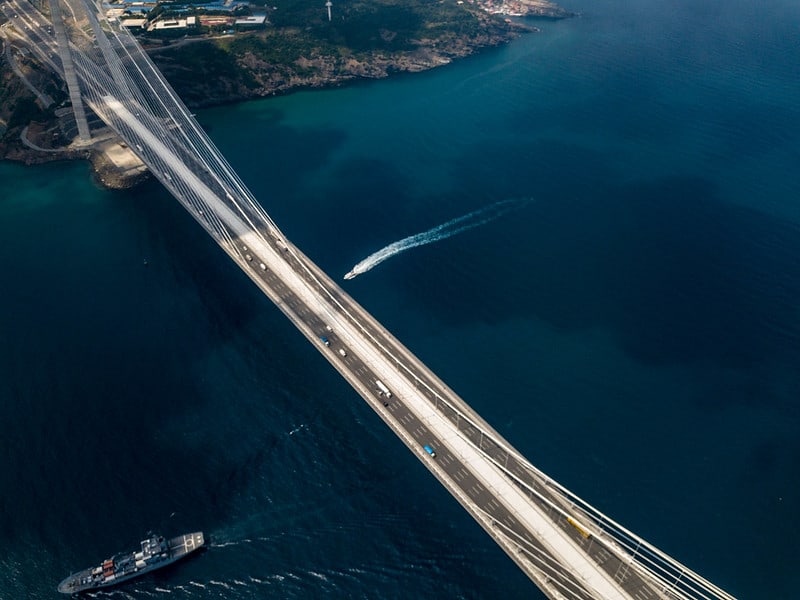
Image sourced from Flickr
It links Garipçe on the European Side to Poyrazköy on the Asian side of Istanbul. Moreover, the bridge lies where the Bosphorus meets the Black Sea. The bridge is named after the 16th-century Ottoman emperor Sultan Selim, the 9th ruler of the empire.
Seen as a symbol of modernization of the country, the third bridge is not without controversy, however. Both its name, its location and the high toll rates have people up in arms. For example, environmentalists had warned that the project is not sustainable and eco-friendly. This is due to the bridge’s close proximity to wetlands, protected areas and the megacity’s water supplies.
Furthermore, unchecked urbanization followed the first two bridges and the surrounding areas. It is predicted that this may be the case with this latest bridge as well. While serving as mayor of Istanbul, Erdoğan had famously said that a third bridge would mean “the murder of Istanbul”. Only time will tell what the newly constructed project will bring about in this relatively remote part of Istanbul.
Planning a trip to Paris ? Get ready !
These are Amazon’s best-selling travel products that you may need for coming to Paris.
Bookstore
- The best travel book : Rick Steves – Paris 2023 – Learn more here
- Fodor’s Paris 2024 – Learn more here
Travel Gear
- Venture Pal Lightweight Backpack – Learn more here
- Samsonite Winfield 2 28″ Luggage – Learn more here
- Swig Savvy’s Stainless Steel Insulated Water Bottle – Learn more here
Check Amazon’s best-seller list for the most popular travel accessories. We sometimes read this list just to find out what new travel products people are buying.

